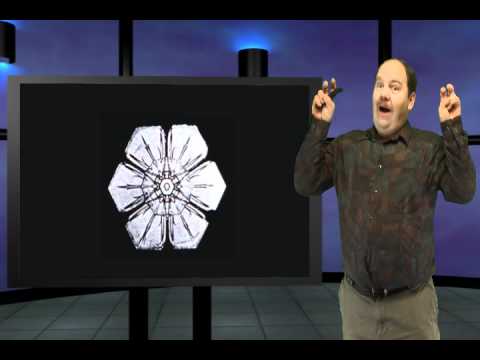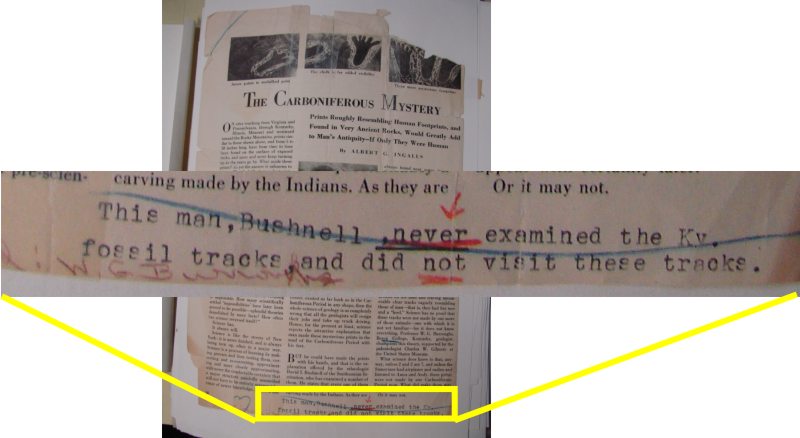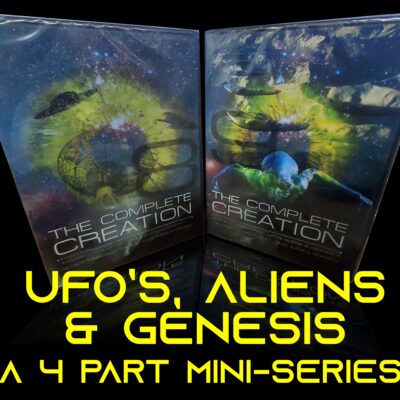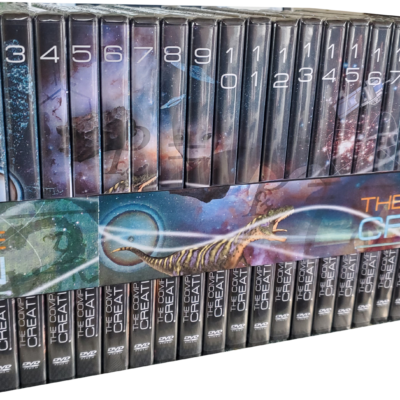
This is the “When I get a round tooit” Creation/Evolution newsletter from Ian Juby and CORE Ottawa
In this special report newsletter showing first-hand research:
1) New program on every week: Genesis Week
2) Keeping up on all the information: More news bites
3) Special report #1: The strange fossil footprints of Berea, Kentucky
4) Upcoming exhibitions
***************************************************************************
1) New program on every week: Genesis Week
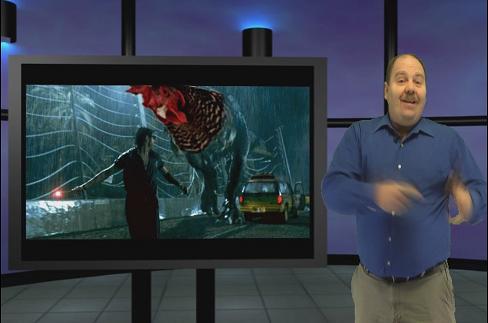
I must first of all apologize for not getting a newsletter out sooner to make this announcement…but alas, I was so busy producing my weekly show I didn’t have a chance to announce it! 🙂
I am very excited to be producing a weekly episode of Genesis Week, available on YouTube every Thursday. We are now on episode 8 of the first season. Every single episode has been in the top ten most discussed videos in science and technology on YouTube.
The owner of the Big Valley Creation Science Museum and the board of CORE Ottawa enjoyed the program so much they have each sponsored the production.
Each week I have dove into the comments (both good and bad) left for the program, and the viewer comments have been very enlightening, becoming a favourite part of the program for viewers.
So here are the first six episodes, rate, rant and enjoy!
If you wish to keep up, you can subscribe to my YouTube channel.
***************************************************************************
2) Keeping up with all the information: More news bites
Some of you will recall that I’ve been attempting to post News bites to my blog whenever I can. News bites are just short little pieces of commentary on a current news item relating to the origins issue. I’ll be referring to these on Genesis Week as well, on the new “ticker tape” feature of the program.
So how can you keep up with the flood of information? If you’re receiving this newsletter, then obviously, you’re already signed up for it. That’s one way – but News bites won’t be included. You can sign up for the News bites via Feedburner – simply visit my blog, and on the right hand side you’ll see “Enter your email address” You’re smart, you can figer out the rest.
If you received this newsletter from a friend and want to sign yourself up, you can sign up here: https://ianjuby.org/csmcsignup.html
***************************************************************************
3) Special report #1: The strange fossil footprints of Berea, Kentucky
Several years back, with the help of friends in high places, I had managed to track down (pun intended) an article from 1940 documenting the Berea, Kentucky fossil human footprints in Carboniferous rocks. Allegedly 250 million years old, fossil footprints in such rock are a huge problem for evolutionists who claim that humans had not evolved until the last 500,000 years or so, and our allegedly ancient hominid ancestors some 5 million years ago.
These footprints had been cited by creationists for years, and fossil human footprints being one of my specialties, I of course wanted to follow up on it. The article was in Scientific American, January issue. It contained four photos of which I took one quick glance, and with disappointment said “Nope, those are carvings, not genuine fossil footprints.”
In fact, it was this very article from which many of you will have undoubtedly heard the quote by author Albert Ingalls, saying:
Hence, for the present at least, science rejects the attractive explanation that man made these mysterious prints in the mud of the Carboniferous Period with his feet.”
Apparently I was not the only one to reject the Berea tracks as carvings, based on the photos provided in SciAm. The story that unfolded over the next year surprised me. A gentleman I had met via the internet, David Willis, had wanted to go to Berea to investigate these tracks. David turned out to be an incredible sleuth, finding out all kinds of details about the tracks and the archives at the college in Berea, as well as another alleged fossil human footprint in Tennessee which I had only seen on television.
I was in Ohio in 2009, and had a couple of days to spare before heading back to Canada. David’s schedule also permitted him time, so we set out to Berea.
Professor Burroughs was the gentleman who originally studied the Berea tracks. A geologist who founded the geology department and taught at Berea college, there is now a small museum named after him in the college. I would dare say that little museum is well worth the visit. http://www.berea.edu/geologymuseum/
Burroughs began his study of the tracks in 1930. These footprints were so remarkably human, that upon suggestion and discussion with Dr. Frank Thone (Science Service, an organization for the popularization of science associated with the Smithsonian) he gave the tracks the latin name “Phenanthropus mirabilis,” which means “looks human; remarkable.”
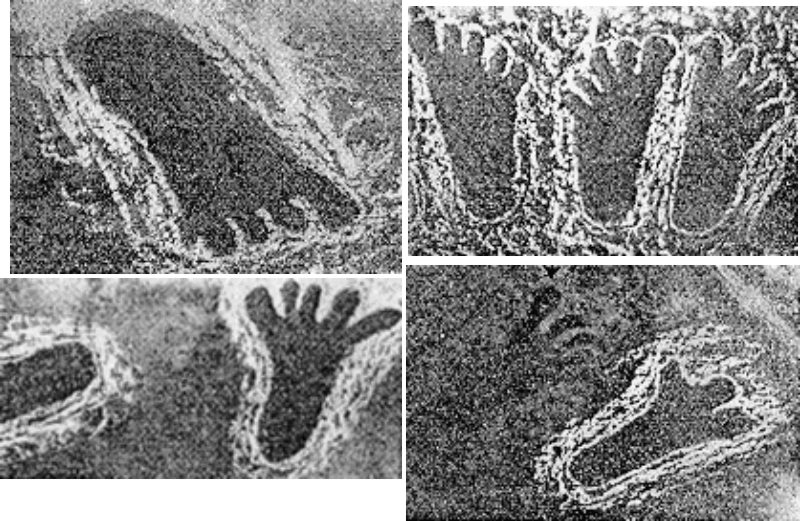 The “fossil tracks” that appeared in January 1940 Scientific American, page 14. Interpreted to be the Berea, Kentucky tracks by talkorigins.org. |
When one looks at the photos provided in the SciAm article, one begins to wonder what drugs Burroughs and Thone were on to give such a name to tracks that do not look human… and so the first surprise came to light when David and I went through the correspondence and photographic archives at the college. With the exception of the upper left “track” in the images above, *none* of the SciAm images even vaguely resembled the Berean footprints. In fact, reading the first paragraph of the SciAm article carefully, one can read between the lines that they admit the photographs are not the Berean tracks!
(emphasis mine)
Notice that they did not say where these particular tracks were found? Notice that they never claimed these tracks were the Berean footprints? The photograph credit was given to F.R. Johnston. Who on earth is F.R. Johnston? We have no idea – because Johnston’s name appears nowhere in any of the boxes of correspondence we looked at in the archives at Berea college. All photographs of the Berea tracks were taken by a local professional photographer by the name of Coleman Ogg of Ogg studios, located right in Berea, whom Borroughs hired to photograph the tracks.
We found a copy of the SciAm article in Burrough’s archives, complete with his disdainful comments on the bottom of the page:
The photographs were not of the Berea tracks, that much was clear. But it would appear that Burroughs did recognize the tracks depicted in the SciAm photos as he complained that Bushnell “did not visit these tracks.“ (emphasis mine)
In fact, in his typical die-hard sleuth fashion that would make Columbo proud, David continued to pursue further information on the whereabouts of the Berea tracks presently, and also obtained Dr. Gilmore’s correspondence from the Smithsonian. In his correspondence with Gilmore, Burroughs sent a photograph of what he called “Indian carvings” he had examined about 30 miles away from the Berea track site. It would appear that somehow the photos that wound up in the SciAm article were of the “Indian carvings” found some 30 miles from the fossil human footprints, which Burroughs had also visited at one point and had determined were Indian carvings (petroglyphs) not tracks.
What we can say is that in all the photographs that David and I examined, as well as pencil rubbings of the Berea tracks, maps, and casts, we saw NO tracks that resembled the photos in the SciAm article. At no place at the Berea site were three tracks found side by side. The toes of the Berea prints most certainly did not look like the toes in the second, third and fourth SciAm images, and the middle inset image (the first image shown in the group above) only vaguely resembles the Berea tracks (and appears to be lacking the fifth toe, which the Berea tracks did not).
The images depicted in the SciAm article arenot the Berea tracks in question.
As if that wasn’t scandalous enough, the Christian Science Monitor also ran a report which contained no photographs of the Berea tracks, but a pencil rubbing of a pair of the tracks, and a fossil trail of amphibian tracks from some unknown location!
 Photographs from Creation Science Monitor, Aug 31, 1938, pg 2, captioned “Upper: Photograph of footprints of a prehistoric creature appearing in solid sandstone on a Kentucky farm. Each foot has five toes, the foot-prints being 9-1/2 inches long and 6 inches across the toes. Darkened area is due to film of oil left on rock after cast of footprints was made. Lower: Photograph of “rubbings” of footprints of one of the prehistoric creatures that left imprints of left and right feet where it stood in damp sand that later hardened into sandstone. Note arch and five toes of each foot.” The errors are glaring: The upper photograph is of a pencil rubbing of a pair of the Berea human tracks (the original pencil rubbing is one of several in the Berea college archives that David and I saw), the lower image is a photograph of fossil amphibian tracks. There is no darkened area caused by film of oil, because the upper image was a pencil rubbing, not the actual fossil. There was still a copy of the press release photo in the Berea archives (left), as well as several original pencil rubbings (click on image for larger size): 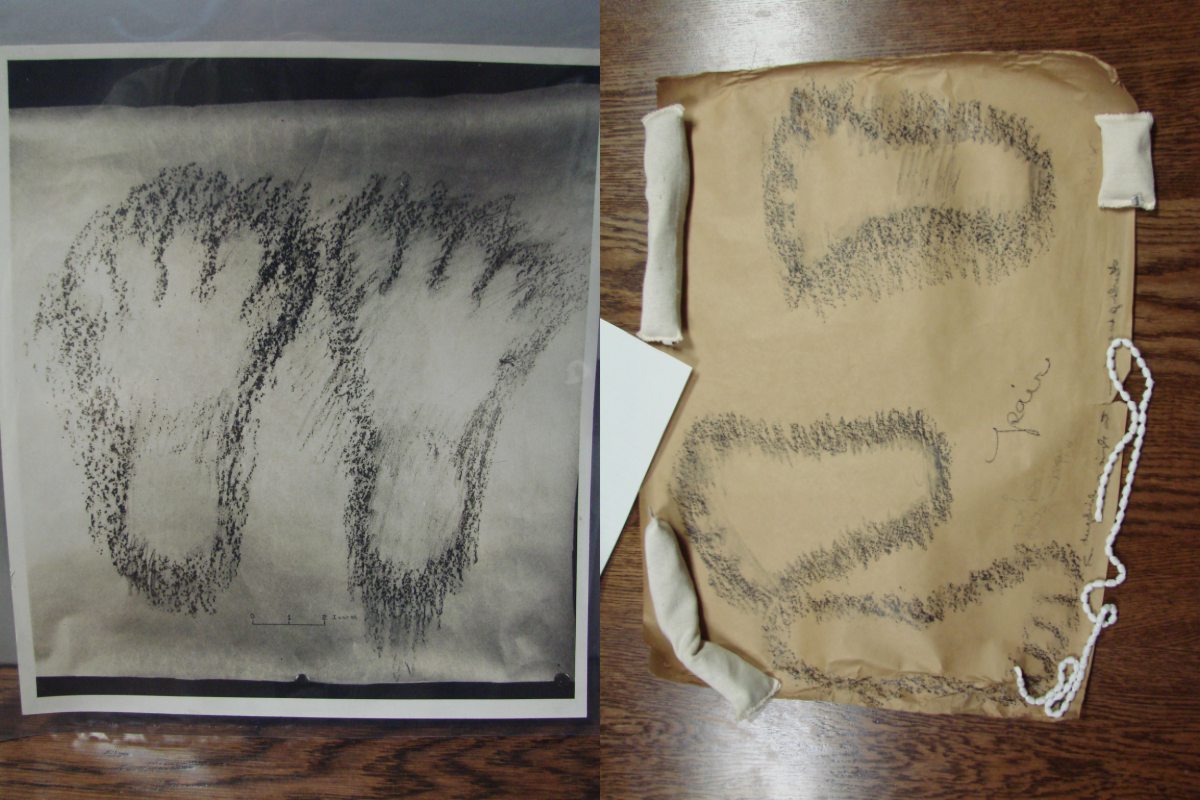 (Photos used with Permission from the Berea College archives www.berea.edu) |
Burroughs pointed out the glaring errors and flagrant misinformation contained in the reports in his correspondence with others.
The Scandal:
The scandalous nature of the reporting of the Berea tracks alone should raise a few eyebrows. Both the SciAm and the Christian Science Monitor articles contained photos implied (or outrightly stated) to be photographs of the Berea tracks which were not the Berea tracks. Both articles interviewed “experts” who then gave their “professional opinion” on the tracks depicted in the non-Berean footprint photographs appearing in the articles. The CSM article even went to the trouble of depicting ten footprints in the amphibian tracks – the number matching the count of the Berean tracks at that time. It would be gracious to call this horrible journalism or gross error. It is probably more accurate to refer to the reports as fraudulent.
Ingalls mentioned that “science” had rejected the human footprint explanation. Actually, scientists of evolutionary persuasion had rejected that interpretation. Their reasons were the same, vacuous reasons I hear regularly when people wish to dismiss profound evidence of man in “old” rock layers.
In fact, reading through Burrough’s private correspondence was quite enlightening, as in almost every instance Burroughs was very careful to always refer to the tracks as “human like.” A letter to Borroughs from Waldemar Kaempffert, Science Editor of the New York Times, read “Dear Sir: The footprints to which you refer in your letter of recent date are probably not human in origin. There is not the slightest fossil evidence that Man was known in this country back of the last Ice Age. Faithfully yours, (signature of Kaempffert).” (dated January 27, 1938. Burroughs noted he wrote back on January 31, 1938)
Burrough’s response was probably the only time he wrote so emphatically: “They are P O S I T I V E L Y human footprints – brought to view thru erosion of millions of years.” Burroughs invited Kaempffert to come see the tracks for himself, but it is unknown whether Kaempffert ever took him up on the offer.
Kaempffert’s response, as well as that of Ingalls, smacks of the typical argumentation which I presented in the second pilot episode of Genesis Week, starting at the 7:37 mark:
http://www.YouTube.com/watch?v=7k0B80oJlQw#t=7m37s
What is the evidence?
So what then is the evidence? The tracks were found in a ledge of rock that was part of the Pottsville formation sandstone. This is one of the original photos of the site straight from Dr. Burrough’s archives:
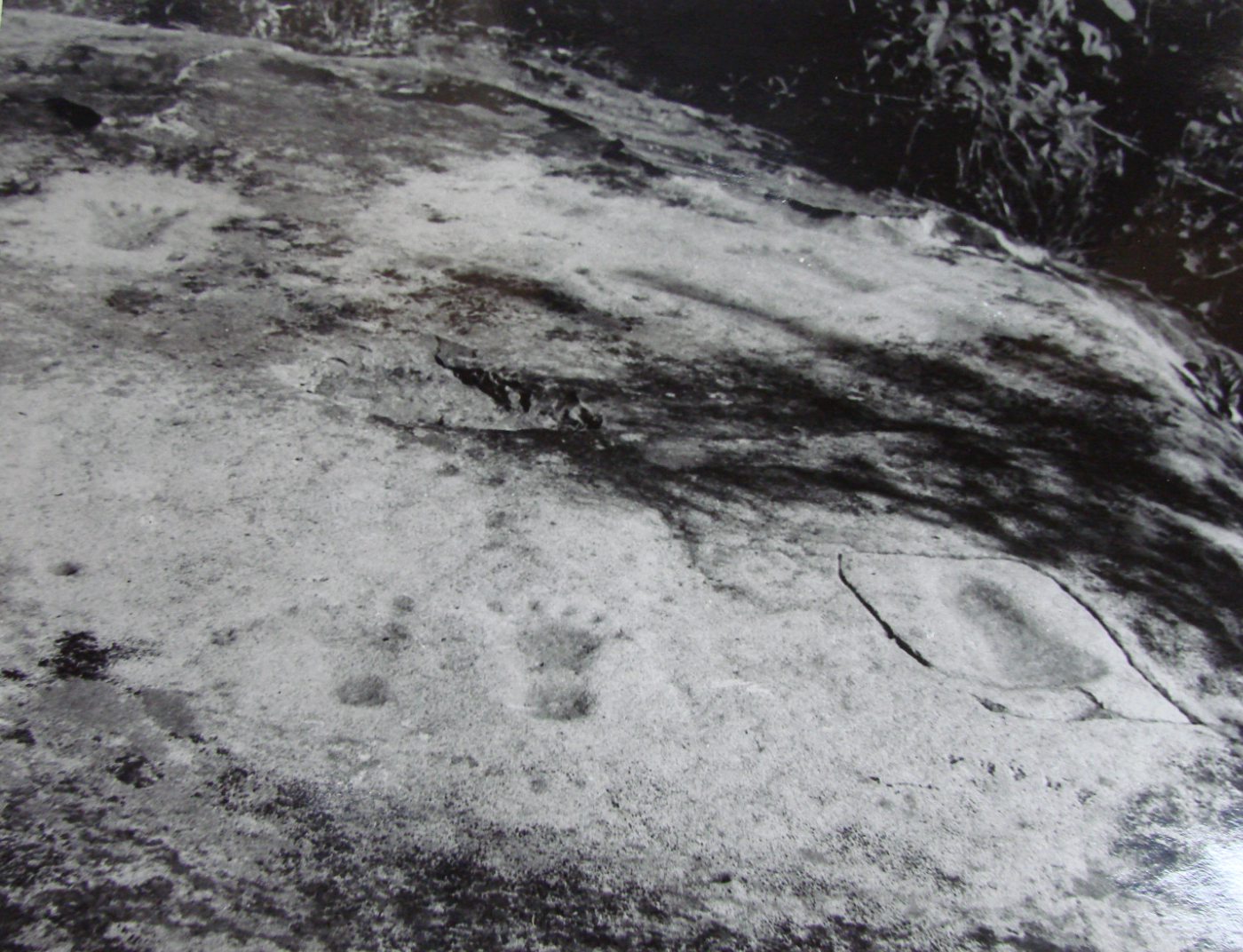
Click on image to view larger image.
(Photo used with Permission from the Berea College archives www.berea.edu)
David and I both obtained wax castings of the Berea tracks from the Berea college museum, and two of these tracks are now part of the new “fossil human footprints” exhibit in my traveling creation museum. See “upcoming exhibitions” down below for more details on how you can see these tracks for yourself.
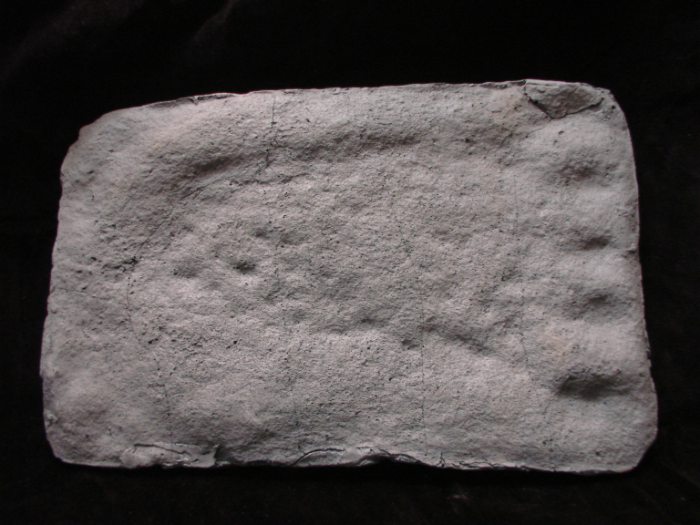 A single footprint from Berea. Notice the displaced mud surrounding the heel which would not be present if the track was a carving. |
While some are the strangest human footprints I have ever seen, I was shocked at what I saw. Namely, there was displaced mud surrounding the prints. This one fact alone convinced me the tracks were genuine, and Burroughs pointed this out repeatedly in his correspondence. Burroughs and others who examined the tracks also pointed out that the grains of sand in the sandstone were more compacted under the tracks, and this compaction was visible under a magnifying glass. One of those persons was an artist and a sculptor by the name of Frank Loug (sp? The signature is difficult to read). Obviously Burroughs was seeking Loug’s opinion as to whether these were carved tracks or not. Loug made an interesting observation to which he wrote in an undated, signed letter (transcribed exactly as written, spelling mistakes are in the original):
I can testify that the sand grains within the tracks are in closer combination than those on the rest of the surface of the stone. They have many appearances of having been compressed by a weight pressure, as the stone surface bulges upwards and outward around the tracks. Then our track, half of which is visible on the surface of the stone, the other half concealed beneath the partly cracked away, overlying layer of newer stone would seem to disprove any argument that these marks were around. All of the marks present an appearance singularly like that of human tracks.”
Indeed, Loug brings up a significant point about a particular track which became exposed over time, of which the heal is only visible in this early photo:
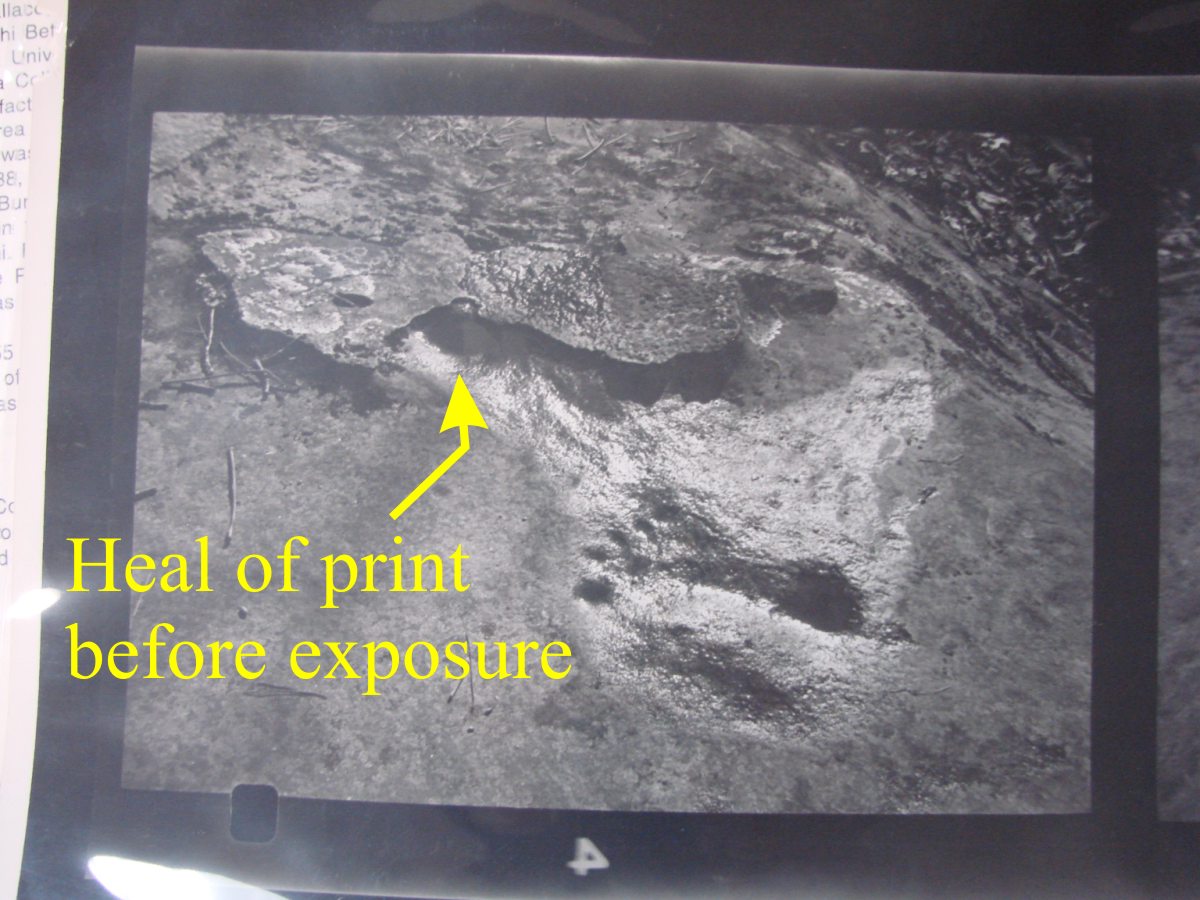
(Click on image for larger version – Photo used with Permission from the Berea College archives www.berea.edu)
This particular track is significant in that it was only exposed after Burroughs had started his research, and several eye witnesses signed a testimony documenting how this track became exposed after the overlying layer had eroded away. The letter reads:
Yours very truly, signed, W.G. Burroughs, M.R. Burroughs, G. Pruitte Sentt(?), Mark H. Clark, W. A. Finnell.
June 28, 1939
This is why the footprint count at the track site varies the reports: originally it was ten tracks, then eleven, then twelve. It is because other footprints were being exposed over time. The tracks are clearly not carvings.
You probably noticed the odd placement of the toes in the first casting. This is actually caused by the person habitually running barefoot. In fact, one person who had visited the Berea tracks with Dr. Burroughs had placed his feet within the Berea tracks and noted the remarkable match:
“My own feet as you will recall, fitted in the tracks perfectly, even to the arches, the only exception being the wider toe spread in the track. During my years residence and travels in Far Eastern Oriental countries, I was a very close observer of the natives, their habits and customs. the foot tracks you discovered could well be those of barefoot natives of remote villages and jungle settlements or those of aboriginal tribes with whom I came in frequent contact, so near do they approach the formation of these prehistoric ‘tracks’. Most cordially yours, A. Merle Hooper” (Private correspondence to Burroughs from A. Merle Hooper, October 18, 1938)
Several of the tracks were in right-left pattern, enabling identification of the track maker as bipedal (walking on two legs).
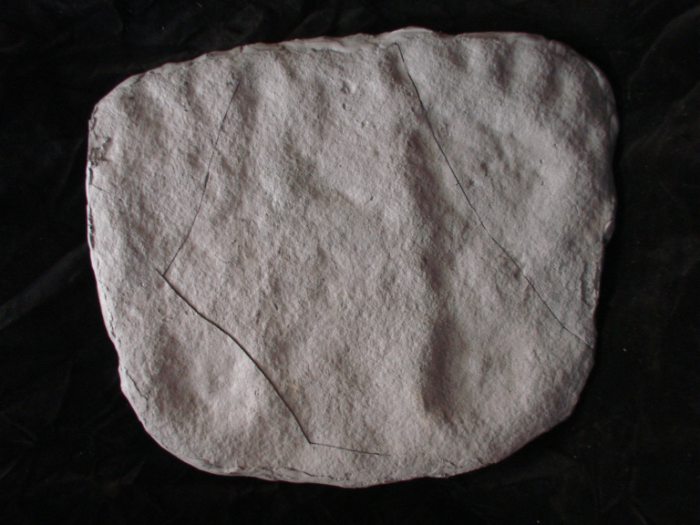 Casting of Berea tracks in the “Fossil Human Footprints” exhibit, Creation Science Museum of Canada. Again, note the displacement of the sand by the footprints. The cracks were in the wax casting, and not the original rock. 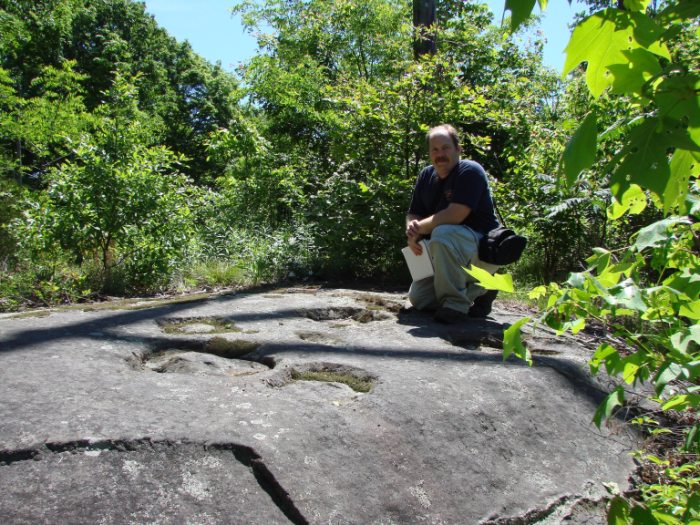 The site of the Berea fossil footprints. Sadly, all the tracks have been cut out of the rock over the past 70+ years. |
Except for his one outburst in response to the New York Times’ science editor Kempffert, you could see Burrough’s own private struggle with the footprints. They were clearly fossil footprints – of that much he was certain. But he knew the ramifications of the tracks being made by humans, and thus struggled with accepting them as human. His struggle can be seen in the words of many of those who have seriously considered and looked into these Carboniferous tracks.
Why the struggle? Because if man has been around since the Carboniferous, then evolution has been rightly falsified. It also means the earth is young, and that Creation is true. The ramifications are spiritual in nature, not physical. Scientific evidence showing the earth is young is not a big deal. Pointing to a Creator God? That is a big deal in the minds of men. The Berea fossil footprints provide excellent evidence of humans in the Carboniferous.
In the next CrEvo News, we’ll give another special report on first-hand research into some mysterious fossil footprints at Horton Bluff, Nova Scotia, which are just as stunning in their ramifications as the Berean footprints.
***************************************************************************
4) Upcoming exhibitions
As I mentioned in a previous newsletter, I am presently upgrading current exhibits and building new ones. My museum will be a stand-alone exhibit and will be on display:
Creation Flood Evidence Museum
Goodwood, Ontario (suburb of Toronto)
April 14 thru April 22nd
Cole Harbour Place, Cole Harbour, Nova Scotia
April 27 thru May 4
If you wish to bring the creation exhibition to your facility, please contact me.
***************************************************************************
These newsletters typically take about 20 to 40 hours worth of work, and I insist on keeping it free. You can support this ministry and get a tax-deductible receipt by mailing a donation (checks made out to CORE Ottawa) to CORE Ottawa, Kanata North Post Office Box 72075, Ottawa, ON. Canada, K2K 2P4 And thank you to those who support both prayerfully and financially. You can also make a direct donation (but not get a tax-deductible receipt) by donating here.
Subscribing and Unsubscribing:
If you received this email from a friend,and would like to subscribe yourself,click hereand enter your email address into the “CSMC” subscribe box. May I also suggest you sign up for the free “In 7 Days” crash course in creation.
If you are forwarding this email to friends,I’d suggest you strip off the unsubscribe link at the bottom here – otherwise someone else will unsubscribe YOU. And thank you for sharing this newsletter! It always pleases me to hear that a reader finds my humble writings worthy to be passed on to a friend of theirs.
